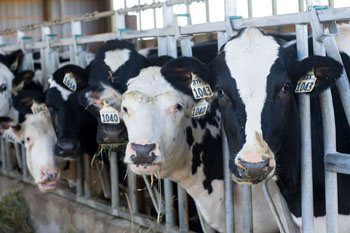Dairy

The Manitoba Dairy Industry consists of approximately 240 producers with an average farm size of 190 cows. Raw milk shipments from dairy farms exceeds 414 million litres annually. All milk produced in Manitoba is processed within the province at eleven plants.
Find other information on financial assistance, environmental programs, animal health and on farm food safety.
Breeding and Reproduction
Quality genetics are fundamental to efficient milk production. The dairy industry has invested heavily in selection programs to consistently improve the yield of dairy cow breeds. Central to a nationwide herd improvement program has been the collection of numerous herd records from individual cows which, alongside trait classification, has produced herds with very high genetic merit. Canadian genetics are sought after worldwide not only for the high production traits but also for the feed conversion efficiency.
Western Canadian Jersey Association
Feeds and Nutrition
Feed is one of the largest operational costs on the average dairy. Dairy feeding programs have direct effects on production and growth as well as farm efficiency. Dairy rations are often complex as the nutritional requirements of the cow have to be balanced effectively against cost of purchased feed and additives while simultaneously keeping wastage to a minimum.
Forages and Fibre
- Can Forage Quality Be Too Good for Cows?
- Corn Silage Harvesting
- Dairy Cows on Pasture (Nutrition Update, Volume 9)
- Mechanical Processing of Corn Silage (Nutrition Update)
- NDF Digestibilities: a New Analysis to Evaluate Forage Quality (Nutrition Update, Volume 14)
- Non-Fibre Carbohydrates in Dairy Diets
- Particle Length in Dairy Diets
Feeding and Health
- Acidosis in Dairy Cows (Nutrition Update, Volume 14)
- Feed Testing: a Valuable Management Tool (Nutrition Update)
- Feeding Heat-Stressed Dairy Cows (Nutrition Update)
- Hoof Health and Nutrition
- Nitrates in Dairy Forages
- Preventing Milk Fevers
- Preventing Udder Edemas in Dairy Cows (Nutrition Update, Volume 13)
- Transition Cows and Displaced Abomasums
- Transition Feeding and Ketosis
- Transition Feeding and Retained Placentas
- When to Sample Silages
Rations
- Can You Feed to Much Protein?
- Changes in the 2001 Nutrient Requirements of Dairy Cattle
- Dealing With High Grain Prices
- Feeding First Calf Heifers
- Heat-Damaged Protein Supplements and Amino Acid Nutrition
- Hulless Barley in Dairy Diets
- Practical Ration Evaluation: Things to Look for to Determine Whether Your Nutritionist is Doing a Good Job (Nutrition Update, Volume 15)
- Ration Guidelines
- Starting Calves on Dry Feed
- Total Mixed Rations (TMR): What Can Go Wrong
- Transition Feeding Guidelines
- What Manure Can Tell About a Feeding Program
- Why Bypass Protein May Not Work
Vitamins, Minerals, Feed Additives and Water
- Are We Feeding Too Much Phosphorus?
- Check Moisture Content Regularly
- Chronic Copper Toxicity: an Increasing Problem? (Nutrition Update, Volume 12)
- Feed Additives in Dairy Diets (Nutrition Update, Volume 11)
- New Nutrients in Dairy Rations?
- The Importance of Vitamin E and Selenium
- Water Quality and Quantity is Critical
Management
Dairy production requires many management strategies to ensure the production of high quality milk. Managing environment, herd structure and daily farm routine are crucial in sustaining production.
Animal Health and Welfare
Health management programs which address disease prevention and control are essential for dairy production. On farm investments in this area will improve the welfare of the animal and in addition, increase the profitability of the dairy operation.

